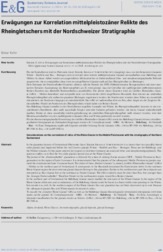| dc.contributor.author | Oskar, Keller | |
| dc.date.accessioned | 2014-06-29T12:53:48Z | |
| dc.date.available | 2014-06-29T12:53:48Z | |
| dc.date.issued | 2014-06-29 | |
| dc.identifier.citation | E&G – Quaternary Science Journal; Vol.63, No.1, p.19-43 | |
| dc.identifier.uri | http://hdl.handle.net/11858/00-1735-0000-0023-B180-B | |
| dc.description.abstract | In the glaciation history of Switzerland (Preusser, Graf, Keller, Krayss & Schlüchter 2011) is shown that two (possibly three) older glacials had happened before the well known glacials Würm = Birrfeld and Riss = Beringen. These are the Habsburg- and the Möhlin-Glacials. In this paper selected key regions in Southern Germany are analysed litho- and morphostratigraphically. This analysis enables us to find the two older glacials proved also at the Rhine Glacier.
The period of the „Deckenschotter“-glaciations is followed by a time of striking fluvial erosion (MPR = Middle Pleistocene Reorganisation) in the region of Lake Constance. It is demonstrated that the glaciers of the subsequent Middle Pleistocene glacials exarated the overdeepened Lake Constance basin. The oldest of these „Becken-Glacials“ is named „Größtes Rheinisches Glazial“ (GRG) = Möhlin in the northern part of Switzerland. It corresponds to the Hosskirch introduced by Ellwanger (2003). In the northern Rhine Glacier region the most external glacial deposits belong to this glaciation. Earlier in the northwestern part these deposits are interpreted as Riss-Glacial, but in the northeast as Mindel-Glacial. The GRG evidently must be older than Riss, but younger than the „Younger Deckenschotter“. Therefore Mindel in the northeastern region would be a Becken-Glacial.
In the northern part of Switzerland the Habsburg-Glacial nearly reached the extension of the Würm-Glacial. In the region of the Rhine Glacier references and/or indications of the Habsburg-Glacial could be found in a band width corresponding to the Würm, but outside it as well. In the northern region of the Rhine Glacier this vast glaciation has not been discovered up to now because the subsequent glacials Riss and Würm mainly destroyed its relics.
To classify the „Greatest Rhine Glacial“ GRG as well as the Habsburg-Glacial chronologically interpolated interglacials with time marks can be applied: IG Unterpfauzenwald – GRG – IG Holstein – Habsburg – IG Meikirch – Riss – IG Eem. Accordingly a temporal classification for the glacials results as follows: (GRG) +350 ka BP (MIS 10), Habsburg +250 ka BP (MIS 8), Riss +150 ka BP (MIS 6). | |
| dc.language.iso | deu | |
| dc.publisher | Geozon Science Media | |
| dc.relation.ispartofseries | E&G – Quaternary Science Journal | |
| dc.subject.ddc | 551.7 | |
| dc.title | Erwägungen zur Korrelation mittelpleistozäner Relikte des Rheingletschers mit der Nordschweizer Stratigraphie | |
| dc.type | article | |
| dc.bibliographicCitation.volume | 63 | |
| dc.bibliographicCitation.issue | 1 | |
| dc.bibliographicCitation.firstPage | 19 | |
| dc.bibliographicCitation.lastPage | 43 | |
| dc.identifier.doi | 10.3285/eg.63.1.02 | |
| dc.identifier.doi | 10.23689/fidgeo-1974 | |
| dc.type.version | Verlagsversion | |
| dc.rights.holder | Geozon Science Media | |
| dc.date.updated | 2014-06-29T12:53:48Z | |
| dc.subject.free | glacial deposits | |
| dc.subject.free | chronostratigraphy | |
| dc.subject.free | alpine foreland | |
| dc.subject.free | glacial drainage | |
| dc.subject.free | Rhine Glacier | |
| dc.relation.volume | E&G – Quaternary Science Journal; Vol.63 | |
| dc.bibliographicCitation.journal | E&G – Quaternary Science Journal | |
| dc.relation.collection | Geologische Wissenschaften | |
| dc.description.type | research | |


